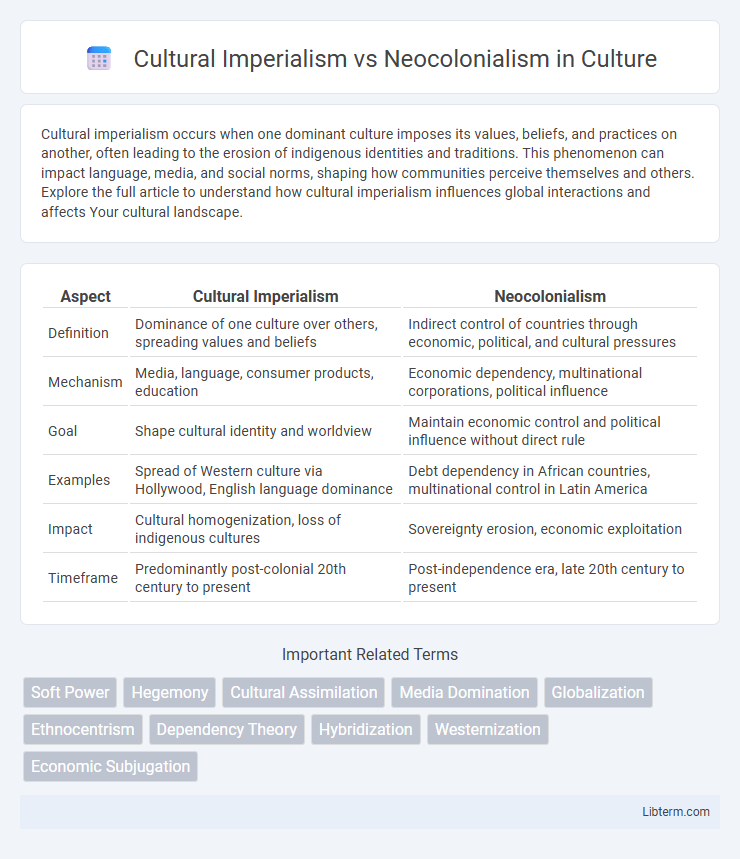Cultural imperialism occurs when one dominant culture imposes its values, beliefs, and practices on another, often leading to the erosion of indigenous identities and traditions. This phenomenon can impact language, media, and social norms, shaping how communities perceive themselves and others. Explore the full article to understand how cultural imperialism influences global interactions and affects Your cultural landscape.
Table of Comparison
| Aspect | Cultural Imperialism | Neocolonialism |
|---|---|---|
| Definition | Dominance of one culture over others, spreading values and beliefs | Indirect control of countries through economic, political, and cultural pressures |
| Mechanism | Media, language, consumer products, education | Economic dependency, multinational corporations, political influence |
| Goal | Shape cultural identity and worldview | Maintain economic control and political influence without direct rule |
| Examples | Spread of Western culture via Hollywood, English language dominance | Debt dependency in African countries, multinational control in Latin America |
| Impact | Cultural homogenization, loss of indigenous cultures | Sovereignty erosion, economic exploitation |
| Timeframe | Predominantly post-colonial 20th century to present | Post-independence era, late 20th century to present |
Introduction to Cultural Imperialism and Neocolonialism
Cultural imperialism refers to the dominance of one culture over others, often through media, language, and consumer products, shaping values and social norms globally. Neocolonialism describes the economic and political control exerted by powerful countries or corporations over developing nations, despite formal independence. Both concepts highlight modern forms of influence that perpetuate inequality and limit true sovereignty.
Defining Cultural Imperialism
Cultural imperialism refers to the dominance of one culture over others, often through media, language, and education, leading to the erosion of local traditions and identities. It operates by imposing the values and norms of a powerful society onto less dominant cultures, frequently as a byproduct of economic and political influence. Unlike neocolonialism, which emphasizes economic and political control, cultural imperialism primarily targets cultural hegemony and social practices.
Understanding Neocolonialism
Neocolonialism refers to the subtle and indirect control exercised by powerful nations or corporations over less developed countries, often through economic, political, and cultural pressures rather than direct military occupation. This modern form of dominance perpetuates dependency by influencing local economies, infrastructure, and governance, ensuring continued resource exploitation and market control. Understanding neocolonialism highlights the ongoing global inequalities masked by formal sovereignty, contrasting with cultural imperialism's focus on imposing cultural values and practices.
Historical Origins of Both Concepts
Cultural imperialism originated in the late 19th century as Western powers expanded their influence through the imposition of language, values, and media on colonized societies, reinforcing dominance without direct political control. Neocolonialism emerged in the mid-20th century following formal decolonization, describing economic and political strategies used by former imperial powers to maintain control over independent nations through economic dependency and political influence. Both concepts highlight evolving mechanisms of domination, with cultural imperialism emphasizing symbolic and ideological control, while neocolonialism centers on economic exploitation and indirect political power.
Key Differences between Cultural Imperialism and Neocolonialism
Cultural imperialism involves the dominance of one culture over others through media, language, and cultural products, leading to the erosion of local identities and values. Neocolonialism refers to the economic and political control exerted by powerful nations over less developed countries through indirect means such as trade policies, multinational corporations, and financial institutions. While cultural imperialism primarily targets cultural influence and identity, neocolonialism centers on economic exploitation and political manipulation to maintain imperial dominance.
Case Studies: Cultural Imperialism in Global Media
Cultural imperialism in global media is exemplified by the overwhelming dominance of Western, particularly American, content that shapes cultural norms and consumer behavior worldwide, as seen in Bollywood's adaptation of Hollywood styles and the widespread diffusion of English-language programming in non-English speaking countries. Case studies reveal that media conglomerates like Disney and Netflix export Western ideologies through films and series, influencing local cultures and overshadowing indigenous narratives. This cultural homogenization contrasts with neocolonialism, where economic and political control persists indirectly, but both mechanisms perpetuate asymmetrical power dynamics favoring former colonial powers.
Economic Mechanisms of Neocolonial Control
Neocolonialism employs economic mechanisms such as debt dependency, unequal trade agreements, and multinational corporate dominance to maintain control over developing nations. These strategies perpetuate economic disparities by extracting resources and profits while limiting local industrial growth. Cultural imperialism complements this by promoting Western consumer values and media, reinforcing economic exploitation through ideological influence.
Impacts on Identity and Local Traditions
Cultural imperialism erodes local identity by imposing dominant cultural values, leading to the homogenization of traditions and loss of indigenous customs. Neocolonialism perpetuates economic and cultural dependence, undermining local autonomy and reinforcing power imbalances that stifle authentic cultural expression. Both phenomena contribute to the weakening of social cohesion and the marginalization of traditional knowledge within affected communities.
Resistance and Counter-Movements
Resistance to cultural imperialism often manifests through the revival and preservation of indigenous languages, traditions, and media, challenging dominant cultural narratives imposed by powerful nations. Counter-movements against neocolonialism emphasize economic self-determination, political sovereignty, and the rejection of foreign control in resource exploitation and governance. These efforts include grassroots activism, cultural nationalism, and international solidarity campaigns aiming to dismantle hegemonic influences and restore local autonomy.
Future Challenges and Evolving Dynamics
Future challenges in cultural imperialism involve resisting the homogenization of local cultures amid globalization and digital media dominance by powerful nations. Neocolonialism's evolving dynamics highlight economic dependency and political influence through transnational corporations and international financial institutions impacting sovereignty. Addressing these issues requires heightened global awareness, equitable cultural exchange practices, and strengthening local cultural identities against external pressures.
Cultural Imperialism Infographic

 libterm.com
libterm.com